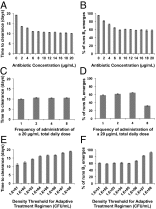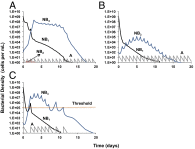Exploring the collaboration between antibiotics and the immune response in the treatment of acute, self-limiting infections
- PMID: 24843148
- PMCID: PMC4060691
- DOI: 10.1073/pnas.1400352111
Exploring the collaboration between antibiotics and the immune response in the treatment of acute, self-limiting infections
Abstract
The successful treatment of bacterial infections is the product of a collaboration between antibiotics and the host's immune defenses. Nevertheless, in the design of antibiotic treatment regimens, few studies have explored the combined action of antibiotics and the immune response to clearing infections. Here, we use mathematical models to examine the collective contribution of antibiotics and the immune response to the treatment of acute, self-limiting bacterial infections. Our models incorporate the pharmacokinetics and pharmacodynamics of the antibiotics, the innate and adaptive immune responses, and the population and evolutionary dynamics of the target bacteria. We consider two extremes for the antibiotic-immune relationship: one in which the efficacy of the immune response in clearing infections is directly proportional to the density of the pathogen; the other in which its action is largely independent of this density. We explore the effect of antibiotic dose, dosing frequency, and term of treatment on the time before clearance of the infection and the likelihood of antibiotic-resistant bacteria emerging and ascending. Our results suggest that, under most conditions, high dose, full-term therapy is more effective than more moderate dosing in promoting the clearance of the infection and decreasing the likelihood of emergence of antibiotic resistance. Our results also indicate that the clinical and evolutionary benefits of increasing antibiotic dose are not indefinite. We discuss the current status of data in support of and in opposition to the predictions of this study, consider those elements that require additional testing, and suggest how they can be tested.
Keywords: immunology; population dynamics.
Conflict of interest statement
The authors declare no conflict of interest.
Figures





Similar articles
-
Exploring the role of the immune response in preventing antibiotic resistance.J Theor Biol. 2009 Feb 21;256(4):655-62. doi: 10.1016/j.jtbi.2008.10.025. Epub 2008 Nov 8. J Theor Biol. 2009. PMID: 19056402 Free PMC article.
-
The population dynamics of antimicrobial chemotherapy.Antimicrob Agents Chemother. 1997 Feb;41(2):363-73. doi: 10.1128/AAC.41.2.363. Antimicrob Agents Chemother. 1997. PMID: 9021193 Free PMC article.
-
Phagocytes, Antibiotics, and Self-Limiting Bacterial Infections.Trends Microbiol. 2017 Nov;25(11):878-892. doi: 10.1016/j.tim.2017.07.005. Epub 2017 Aug 24. Trends Microbiol. 2017. PMID: 28843668 Review.
-
Bacterial fitness shapes the population dynamics of antibiotic-resistant and -susceptible bacteria in a model of combined antibiotic and anti-virulence treatment.J Theor Biol. 2015 May 7;372:1-11. doi: 10.1016/j.jtbi.2015.02.011. Epub 2015 Feb 18. J Theor Biol. 2015. PMID: 25701634 Free PMC article.
-
What do we really know about antibiotic pharmacodynamics?Pharmacotherapy. 2001 Nov;21(11 Pt 2):302S-318S. doi: 10.1592/phco.21.18.302s.33905. Pharmacotherapy. 2001. PMID: 11714222 Review.
Cited by
-
Collateral sensitivity counteracts the evolution of antifungal drug resistance in Candida auris.Nat Microbiol. 2024 Nov;9(11):2954-2969. doi: 10.1038/s41564-024-01811-w. Epub 2024 Oct 29. Nat Microbiol. 2024. PMID: 39472696
-
A multi-scale approach to designing therapeutics for tuberculosis.Integr Biol (Camb). 2015 May;7(5):591-609. doi: 10.1039/c4ib00295d. Epub 2015 Apr 30. Integr Biol (Camb). 2015. PMID: 25924949 Free PMC article.
-
Diverse drug-resistant subpopulations of Mycobacterium tuberculosis are sustained in continuous culture.J R Soc Interface. 2016 Nov;13(124):20160745. doi: 10.1098/rsif.2016.0745. J R Soc Interface. 2016. PMID: 27807274 Free PMC article.
-
Mathematical Models for Immunology: Current State of the Art and Future Research Directions.Bull Math Biol. 2016 Oct;78(10):2091-2134. doi: 10.1007/s11538-016-0214-9. Epub 2016 Oct 6. Bull Math Biol. 2016. PMID: 27714570 Free PMC article. Review.
-
Tissue compartmentalization enables Salmonella persistence during chemotherapy.Proc Natl Acad Sci U S A. 2021 Dec 21;118(51):e2113951118. doi: 10.1073/pnas.2113951118. Proc Natl Acad Sci U S A. 2021. PMID: 34911764 Free PMC article.
References
-
- Craig WA. Pharmacokinetic/pharmacodynamic parameters: Rationale for antibacterial dosing of mice and men. Clin Infect Dis. 1998;26(1):1–10, quiz 11–12. - PubMed
-
- Drusano GL. Pharmacokinetics and pharmacodynamics of antimicrobials. Clin Infect Dis. 2007;45(Suppl 1):S89–S95. - PubMed
-
- Mattie H. Kinetics of antimicrobial action. Rev Infect Dis. 1981;3(1):19–27. - PubMed
-
- Garrett ER, Miller GH, Brown MR. Kinetics and mechanisms of action of antibiotics on microorganisms. V. Chloramphenicol and tetracycline affected Escherichia coli generation rates. J Pharm Sci. 1966;55(6):593–600. - PubMed
-
- Garrett ER, Won CM. Kinetics and mechanisms of drug action on microorganisms. XVII. Bactericidal effects of penicillin, kanamycin, and rifampin with and without organism pretreatment with bacteriostatic chloramphenicol, tetracycline, and novobiocin. J Pharm Sci. 1973;62(10):1666–1673. - PubMed
Publication types
MeSH terms
Substances
Grants and funding
LinkOut - more resources
Full Text Sources
Other Literature Sources
Medical

